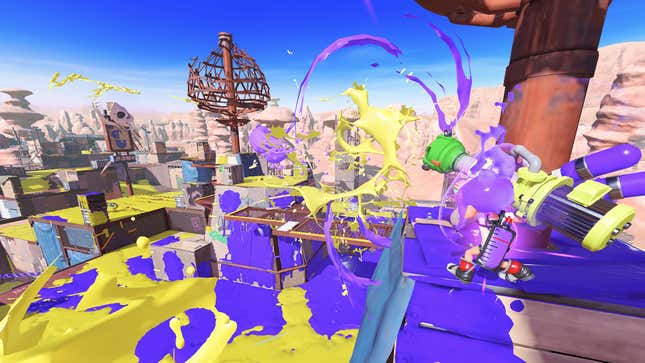
Every Friday, A.V. Club staffers kick off our weekly open thread for the discussion of gaming plans and recent gaming glories, but of course, the real action is down in the comments, where we invite you to answer our eternal question: What Are You Playing This Weekend?
Splatoon 3 doesn’t need me. That’s true in multiple senses. On a sales front, it seems unlikely that Nintendo’s latest Great IP Success is going to need my support to make its third installment—and the second on the uber-popular Switch—a massive win. Just seven years old as a franchise, Splatoon is already an institution at this point, with its own traditions, in-jokes, memes, etc., all leaking out of the game and onto the internet like so much mutant squid ink. (It is, if nothing else, certainly the most successful entity to ever pull itself from the Mii-strewn blast crater left behind by Nintendo’s lamentable Wii U.)
But there’s also a sense that Splatoon doesn’t need me: A 38-year-old guy who’s always been mildly interested in this series, but never taken the plunge and gotten my feet, uh, inked. It’s not that the third game, out last week, isn’t well-tutorialized—it is, walking newbies like me through the basics of jumping into either its online multiplayer or its robust single-player story mode. But as a primer on the philosophy of Splatoon, there’s a definite sense that I should absolutely already know all of this stuff by now, whether it’s the game’s approach to combat, or its fashion, or its music, or what have you.
Which is frustrating, insofar as Splatoon is a profoundly weird, and not entirely intuitive, model for an online shooter, at least for an uninitiated oldster like myself. From a few days of intensive play—bouncing between the story mode, the online shooting, and the players-versus-enemies Salmon Run mode—it’s possible to derive some first principles, the sort of thing that would make me sound like a dope if I was reciting them to any veteran player. (An example, to ensure said series vets get a good eye roll in: Understanding that the whole “ink” thing isn’t just a stand-in for guns and bullets, but also a nuanced and dynamic model for territory control. Well-inked territory isn’t just the score in the game’s basic Turf War mode: It’s an ammo depot, an enemy debuff, and an escape route all in one. Splatoon players have known that since the mid-2010s, but I’m over here, flailing around in catch-up mode.)
There’s also the need for me to adjust to the basic fragility of the Squidlings, who can typically die in about a second of sustained fire, a single touch of a big deadly paint roller, or a couple of blasts from a long-range weapon. There are shooter games that are all about surviving what happens after you get hit, managing your incoming fire for a safe withdrawal or a daring push. But Splatoon is, to my newbie eyes, a game that’s first and foremost about not getting hit in the first place, whether that’s by deftly managing the range of whichever of the diverse array of guns you’ve decided to bring into a match, using your assigned sub-weapon to surprise or distract enemies, or simply by always having an escape route ready for you to swim away via using the Squidlings’ distinctive submerge ability. In philosophy, it feels like a game for the ambusher, the kind of player who delights in hitting an opponent from an oblique angle, wiping them out before the opponent even knows they’re there.
Do I like it? Wading through the unappealing aesthetics of the whole package—a sanitized regurgitation of about 8 different youth sub-cultures, mashed together with character designs my brain is hard-locked from seeing as cute—I can’t help but find something compelling lurking underneath the surface. Nintendo has always had a talent for re-inventing the wheel in ways that find the unseeable flaw in the original, fixing it seemingly effortlessly with an engaging mix of confidence and naivety, and seeing them apply that mindset to shooters as a whole is fascinating. If nothing else, I’ll never be able to look at the ways fighters array on a virtual map in any other shooter the same way without thinking about gallons of ink splashed across the battlefield, spelling out who has control over what in a precise but messy sort of way.
Already, though, I can sense that I’m going to be a tourist here in Splatsville. An appreciative and enthusiastic one, to be sure, getting as much from my visit as I can before the locals casually blow past me. But Splatoon 3 doesn’t need me, with my wandering attention span, my aging eyes, and my ever-growing backlog of unfinished games. (Oh, Monster Hunter Rise: Sunbreak: I swear I’ll get back to finishing you someday.) It needs the faithful, the ones who literally shaped this world with their devotion to the franchise’s regular Splatfest events. (Splatoon 3 was reportedly inspired in part by “Chaos” winning in the final of those big online fights; given how bewildering the game can be, it’s very difficult to imagine what “Order” would have looked like, instead.) I’ve written, more than once, about the pursuit of the “Forever Game”—the game that keeps players hooked for years, changing with them, evolving, inescapable. Splatoon 3 isn’t the Forever Game, for me. But it does allow me to imagine the person for whom it is—and not without a touch of envy.